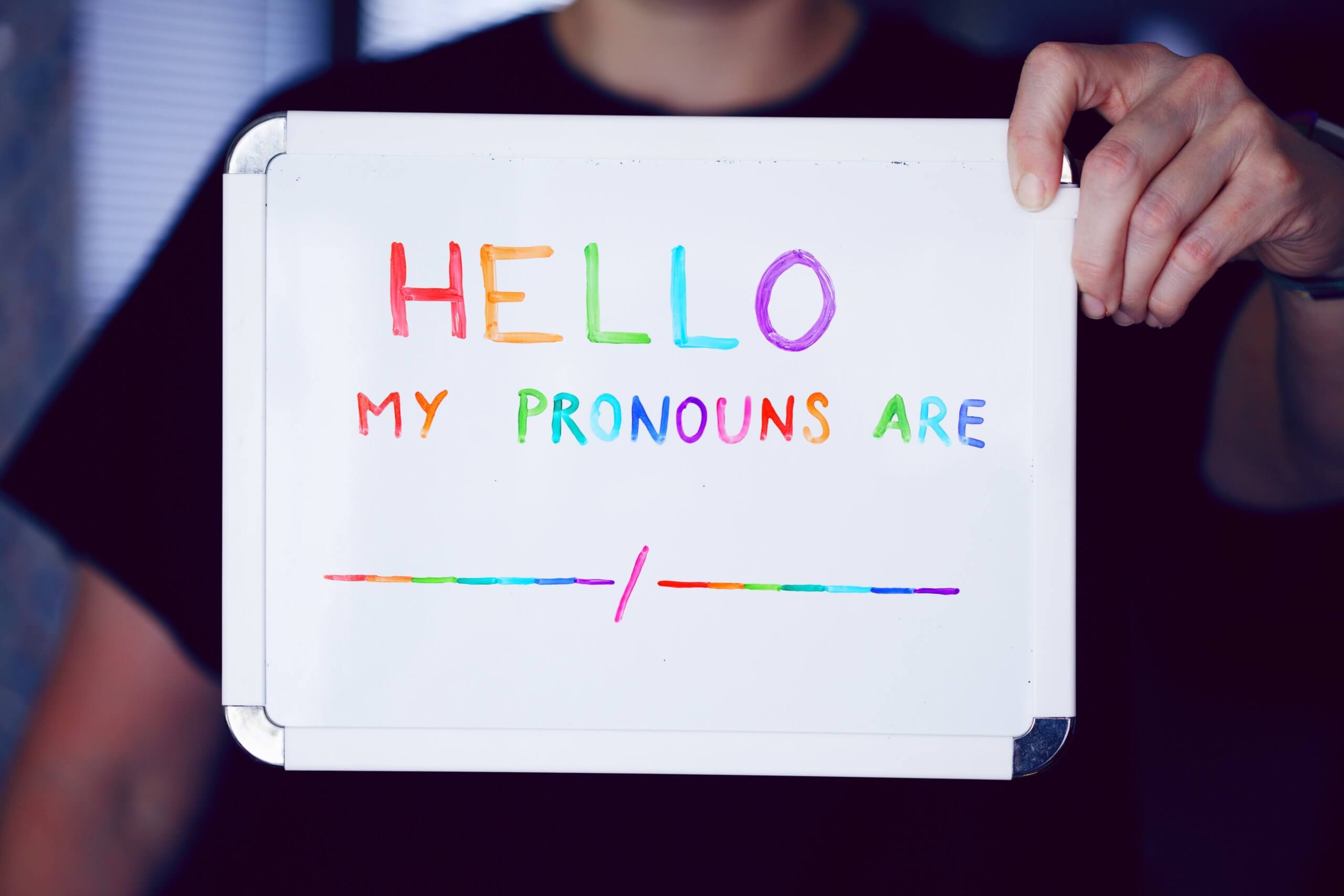So much of our language is gendered. If you’ve never questioned your gender identity, you might not notice or realize how often certain words are associated with gender.
When a family member dismisses language that corresponds with the way a transgender person sees themselves—be that their pronouns or their chosen name—it can damage the relationship. And when a family member intentionally misgenders someone it can be outright humiliating, negatively affecting the overall mental and emotional health of the transgender person.
Everyone deserves respect and consideration and to be addressed in a way that affirms, not diminishes, their identity.
Starting a conversation with your family members about your gender identity and using inclusive language is no small feat. Here are some tips you can use to make your discussion as healthy as possible.
Tip #1: Organize your thoughts and set boundaries

When I first started questioning my gender, I found it helpful to talk to my parents about my thoughts as well as my frustration with how trans friends were mistreated in their daily lives. This helped them understand how much I thought about such matters and how important it was to me. However, you’re not obligated to share details of your personal life with family, especially if someone is being hostile.
Before starting the conversation with your family, take some time to outline a few points you want to make in your discussion and their significance. You might want to define some key terms used in LGBTQIA+ spaces, the difference between sex and gender, or explain some of your own feelings. It’s also okay if you don’t have a clear understanding of what your identity is —this is not a race, and it might not be easy to articulate the first time you try to talk about it.
I needed to reflect on these feelings for about three years before I was able to talk about my gender with certainty. An outline and this kind of thought exercise will help you organize your thoughts and decide what you do want to communicate, be that a well-established sense of self or that you are still figuring some things out.
Your sense of comfort comes first. If you’re not ready to talk to your relatives face-to-face just yet, try writing them a letter or sending a text. If you’re afraid to start the conversation alone, ask a friend to be present for you via video chat or text.
RELATED: 9 Ways to Support Your Transitioning Partner
Tip #2: Manage your expectations

If you’re in a safe environment, insist that your family use your pronouns. You can also ask to try out different pronouns to see what works best for you! It might take them a little while to get used to using a new language, but as long as they are respectful and committed to improving, you can patiently correct them.
It’s also okay to have different sets of expectations for different family members; you might press your parents to work harder than your grandparent struggling with a memory or health issue. You don’t have to give yourself an “all or nothing” ultimatum — pay attention to what feels right for you.
Tip #3: Frame the conversation as a positive support tool, not a penalty

If you feel like your family member is receptive to a discussion about gendered language, this can be a great opportunity to call them in. If they misstep, hold them accountable while prioritizing their learning—don’t chastise them for doing something wrong in front of others. Tell them you’re having this discussion to help them and because you want them to have more tools to treat others with respect.
Tip #4: Avoid using jargon
Unfortunately, many gender theorists use a lot of jargon that won’t serve you in your day-to-day conversations if your family members have a steeper learning curve than most. If you’re using plain language, it will help everyone to feel more comfortable as the conversation progresses. You can build on this foundation in the future and introduce more sophisticated concepts and language over time.
Tip #5: Address microaggressions

Sometimes, good intentions aren’t enough. If your family member says something that’s intended to be supportive but implies that cis people are more authentic or the ideal beauty standard, it’s an opportunity for you to point out that they have some more learning to do. You want to feel closer to your loved one, and the point of this conversation isn’t to make you feel like “The Other”. You might respond to microaggressions by saying:
- “Hey, so I don’t know if you realize this, but saying that I’m really pretty for a trans girl implies that most trans women can’t be beautiful.”
- “It might be a good idea for you to work on saying ‘cis’ instead of ‘real.’ Trans people are real, existing people!”
- “It’s generally considered bad manners to just randomly ask someone about their genitals or invasive medical procedures, and that still applies to trans people in your life.”
But if your identity is dismissed or belittled, that’s another matter. Anyone who tries to make you feel small is exhibiting unhealthy relationship behaviors. If you don’t feel like your relative is engaging with you in good faith or you discover that they have a lot more work to do, it’s okay to take a step back.
RELATED: Relationship Abuse among LGBTQIA* Communities
Tip #6: Use anecdotal evidence

Instead of theory, focus on people, experiences, and feelings. You can talk about yourself, someone you know, or someone you follow on social media. Explain that being referred to by certain pronouns, terms of address, or adjectives can impact someone’s emotional well-being. If you express that hearing the wrong pronouns constantly makes you feel like people’s perception of you conflicts with your sense of self, it helps establish cause and effect. Talking about how gender-affirming language helps with one’s confidence is a much easier idea for folks to process than a barrage of specific terms. Being asked to use a specific pronoun or to use the word “handsome” instead of “pretty” is easier to act on than listening to a lecture on gender identities.
Tip #7: Share resources

It’s not your job to know everything about transgender issues, gender theory, or what all trans people are doing. It’s unreasonable for anyone to expect you to represent an entire segment of the population.
Adults in your life can support you by doing their own research on trans and gender-nonconforming identities. It can be helpful to have some resources (websites, articles, etc.) handy to share with your relatives. If your conversation comes to a point where it feels more like a vocabulary quiz, you can redirect your relatives to these resources to learn more.
Human Rights Campaign has a good primer for parents of trans children, and PFLAG is an organization dedicated to helping people support their LGBTQIA+ relatives and loved ones.
Ultimately, you have the power to decide to engage (or not) with family members if this is a tough topic for them to wrap their heads around. If you do want to have the discussion, try grounding it in the personal and use plain language. If talking about people you know doesn’t do enough to contextualize the issue, you can try referring family members to specific resources. Don’t give up if you don’t feel understood the first time you talk about these issues! You might notice that someone who has been taught about gender from a cis perspective feels uncomfortable the first time they are presented with the full spectrum. Feeling uncomfortable is okay. They can grow from that place, especially when it’s to support someone they love.
Looking for resources to lead a more inclusive One Love workshop? Sign up for our Education Center to download our free LGBTQ+ toolkit.
Browse by Category

Don’t Be on the Naughty List: Spotting Unhealthy Relationship Signs This Holiday Season
The holidays are meant for joy, connection, and celebration—whether it’s Christmas, Hanukkah, Kwanzaa, or cozy winter vibes. But if someone…
How to Have Healthy Holiday Conversations with Family (and Prep Your Partner)
The holidays are a time for family, good food, and—let's…
Finding Strength in Our Stories: Domestic Violence Awareness Month
⚠️ Trigger Warning: This blog includes content and language related…
Understanding Domestic Violence Awareness Month (DVAM)
October is almost here, and that means it’s time to…
4 Students Share How They Helped a Friend in an Unhealthy Relationship
Watching a friend struggle in an unhealthy or abusive relationship…














